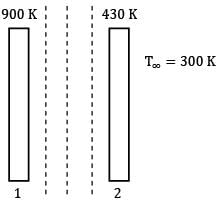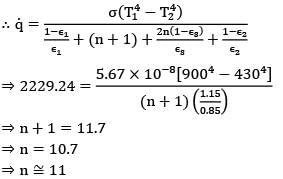Chemical Engineering Exam > Chemical Engineering Questions > An industrial furnace employs a hollow brick...
Start Learning for Free
An industrial furnace employs a hollow brick lining. The inside and outside surfaces of the hollow brick lining are maintained at 900 K and 430 K by placing radiation shields in between the hollow space. The heat loss occurs to the surroundings (300 K) by both radiation and natural convection. Calculate number of shields needed. The emissivity of walls and shields can be taken as 0.85. The convective heat transfer coefficient is governed by the expression
h = 1.5(ΔT)0.33 W/m2- K
- a)11.0
- b)11.0
Correct answer is option ''. Can you explain this answer?
Verified Answer
An industrial furnace employs a hollow brick lining. The inside and o...
Heat lost by outer surface of the lining to surroundings per unit area,

View all questions of this test
q = εσ(T24 - Tထ4)
q = 0.85 x 5.67 10-8[4304 - 3004]+1.5(430 -300)0.33 x (430 - 300)
q = 1257.3116 + 971.932
q = 2229.24 W

n-shields
∴ Heat transfer from surface 1 to 2 through n-shields must be equal to ̇q

⇒ 2229.24 = 

⇒ n+1 = 11.7
⇒ n = 10.7
⇒ n ≅ 11
Question_type 5
Most Upvoted Answer
An industrial furnace employs a hollow brick lining. The inside and o...
Heat lost by outer surface of the lining to surroundings per unit area,

q = εσ(T24 - Tထ4)
q = 0.85 x 5.67 10-8[4304 - 3004]+1.5(430 -300)0.33 x (430 - 300)
q = 1257.3116 + 971.932
q = 2229.24 W

n-shields
∴ Heat transfer from surface 1 to 2 through n-shields must be equal to ̇q

⇒ 2229.24 = 

⇒ n+1 = 11.7
⇒ n = 10.7
⇒ n ≅ 11
Question_type 5
Free Test
FREE
| Start Free Test |
Community Answer
An industrial furnace employs a hollow brick lining. The inside and o...
Heat lost by outer surface of the lining to surroundings per unit area,

q = εσ(T24 - Tထ4)
q = 0.85 x 5.67 10-8[4304 - 3004]+1.5(430 -300)0.33 x (430 - 300)
q = 1257.3116 + 971.932
q = 2229.24 W

n-shields
∴ Heat transfer from surface 1 to 2 through n-shields must be equal to ̇q

⇒ 2229.24 = 

⇒ n+1 = 11.7
⇒ n = 10.7
⇒ n ≅ 11
Question_type 5

|
Explore Courses for Chemical Engineering exam
|

|
Question Description
An industrial furnace employs a hollow brick lining. The inside and outside surfaces of the hollow brick lining are maintained at 900 K and 430 K by placing radiation shields in between the hollow space. The heat loss occurs to the surroundings (300 K) by both radiation and natural convection. Calculate number of shields needed. The emissivity of walls and shields can be taken as 0.85. The convective heat transfer coefficient is governed by the expressionh = 1.5(ΔT)0.33 W/m2- Ka) 11.0b) 11.0Correct answer is option ''. Can you explain this answer? for Chemical Engineering 2025 is part of Chemical Engineering preparation. The Question and answers have been prepared according to the Chemical Engineering exam syllabus. Information about An industrial furnace employs a hollow brick lining. The inside and outside surfaces of the hollow brick lining are maintained at 900 K and 430 K by placing radiation shields in between the hollow space. The heat loss occurs to the surroundings (300 K) by both radiation and natural convection. Calculate number of shields needed. The emissivity of walls and shields can be taken as 0.85. The convective heat transfer coefficient is governed by the expressionh = 1.5(ΔT)0.33 W/m2- Ka) 11.0b) 11.0Correct answer is option ''. Can you explain this answer? covers all topics & solutions for Chemical Engineering 2025 Exam. Find important definitions, questions, meanings, examples, exercises and tests below for An industrial furnace employs a hollow brick lining. The inside and outside surfaces of the hollow brick lining are maintained at 900 K and 430 K by placing radiation shields in between the hollow space. The heat loss occurs to the surroundings (300 K) by both radiation and natural convection. Calculate number of shields needed. The emissivity of walls and shields can be taken as 0.85. The convective heat transfer coefficient is governed by the expressionh = 1.5(ΔT)0.33 W/m2- Ka) 11.0b) 11.0Correct answer is option ''. Can you explain this answer?.
An industrial furnace employs a hollow brick lining. The inside and outside surfaces of the hollow brick lining are maintained at 900 K and 430 K by placing radiation shields in between the hollow space. The heat loss occurs to the surroundings (300 K) by both radiation and natural convection. Calculate number of shields needed. The emissivity of walls and shields can be taken as 0.85. The convective heat transfer coefficient is governed by the expressionh = 1.5(ΔT)0.33 W/m2- Ka) 11.0b) 11.0Correct answer is option ''. Can you explain this answer? for Chemical Engineering 2025 is part of Chemical Engineering preparation. The Question and answers have been prepared according to the Chemical Engineering exam syllabus. Information about An industrial furnace employs a hollow brick lining. The inside and outside surfaces of the hollow brick lining are maintained at 900 K and 430 K by placing radiation shields in between the hollow space. The heat loss occurs to the surroundings (300 K) by both radiation and natural convection. Calculate number of shields needed. The emissivity of walls and shields can be taken as 0.85. The convective heat transfer coefficient is governed by the expressionh = 1.5(ΔT)0.33 W/m2- Ka) 11.0b) 11.0Correct answer is option ''. Can you explain this answer? covers all topics & solutions for Chemical Engineering 2025 Exam. Find important definitions, questions, meanings, examples, exercises and tests below for An industrial furnace employs a hollow brick lining. The inside and outside surfaces of the hollow brick lining are maintained at 900 K and 430 K by placing radiation shields in between the hollow space. The heat loss occurs to the surroundings (300 K) by both radiation and natural convection. Calculate number of shields needed. The emissivity of walls and shields can be taken as 0.85. The convective heat transfer coefficient is governed by the expressionh = 1.5(ΔT)0.33 W/m2- Ka) 11.0b) 11.0Correct answer is option ''. Can you explain this answer?.
Solutions for An industrial furnace employs a hollow brick lining. The inside and outside surfaces of the hollow brick lining are maintained at 900 K and 430 K by placing radiation shields in between the hollow space. The heat loss occurs to the surroundings (300 K) by both radiation and natural convection. Calculate number of shields needed. The emissivity of walls and shields can be taken as 0.85. The convective heat transfer coefficient is governed by the expressionh = 1.5(ΔT)0.33 W/m2- Ka) 11.0b) 11.0Correct answer is option ''. Can you explain this answer? in English & in Hindi are available as part of our courses for Chemical Engineering.
Download more important topics, notes, lectures and mock test series for Chemical Engineering Exam by signing up for free.
Here you can find the meaning of An industrial furnace employs a hollow brick lining. The inside and outside surfaces of the hollow brick lining are maintained at 900 K and 430 K by placing radiation shields in between the hollow space. The heat loss occurs to the surroundings (300 K) by both radiation and natural convection. Calculate number of shields needed. The emissivity of walls and shields can be taken as 0.85. The convective heat transfer coefficient is governed by the expressionh = 1.5(ΔT)0.33 W/m2- Ka) 11.0b) 11.0Correct answer is option ''. Can you explain this answer? defined & explained in the simplest way possible. Besides giving the explanation of
An industrial furnace employs a hollow brick lining. The inside and outside surfaces of the hollow brick lining are maintained at 900 K and 430 K by placing radiation shields in between the hollow space. The heat loss occurs to the surroundings (300 K) by both radiation and natural convection. Calculate number of shields needed. The emissivity of walls and shields can be taken as 0.85. The convective heat transfer coefficient is governed by the expressionh = 1.5(ΔT)0.33 W/m2- Ka) 11.0b) 11.0Correct answer is option ''. Can you explain this answer?, a detailed solution for An industrial furnace employs a hollow brick lining. The inside and outside surfaces of the hollow brick lining are maintained at 900 K and 430 K by placing radiation shields in between the hollow space. The heat loss occurs to the surroundings (300 K) by both radiation and natural convection. Calculate number of shields needed. The emissivity of walls and shields can be taken as 0.85. The convective heat transfer coefficient is governed by the expressionh = 1.5(ΔT)0.33 W/m2- Ka) 11.0b) 11.0Correct answer is option ''. Can you explain this answer? has been provided alongside types of An industrial furnace employs a hollow brick lining. The inside and outside surfaces of the hollow brick lining are maintained at 900 K and 430 K by placing radiation shields in between the hollow space. The heat loss occurs to the surroundings (300 K) by both radiation and natural convection. Calculate number of shields needed. The emissivity of walls and shields can be taken as 0.85. The convective heat transfer coefficient is governed by the expressionh = 1.5(ΔT)0.33 W/m2- Ka) 11.0b) 11.0Correct answer is option ''. Can you explain this answer? theory, EduRev gives you an
ample number of questions to practice An industrial furnace employs a hollow brick lining. The inside and outside surfaces of the hollow brick lining are maintained at 900 K and 430 K by placing radiation shields in between the hollow space. The heat loss occurs to the surroundings (300 K) by both radiation and natural convection. Calculate number of shields needed. The emissivity of walls and shields can be taken as 0.85. The convective heat transfer coefficient is governed by the expressionh = 1.5(ΔT)0.33 W/m2- Ka) 11.0b) 11.0Correct answer is option ''. Can you explain this answer? tests, examples and also practice Chemical Engineering tests.

|
Explore Courses for Chemical Engineering exam
|

|
Signup for Free!
Signup to see your scores go up within 7 days! Learn & Practice with 1000+ FREE Notes, Videos & Tests.























